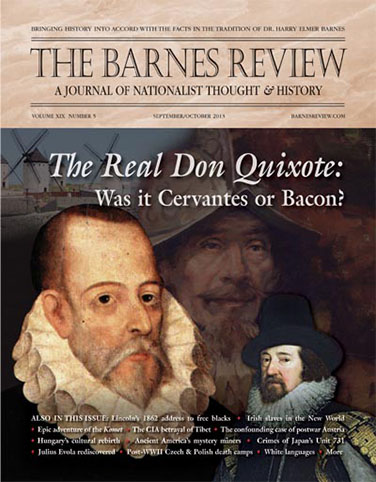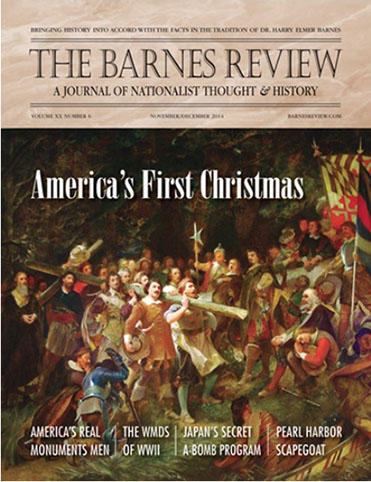Description
The Barnes Review
A JOURNAL OF POLITICALLY INCORRECT HISTORY
September/October 2013 ❖ VOLUME XIX ❖ NUMBER 5
TABLE OF CONTENTS
WHO REALLY WROTE DON QUIXOTE?
By John Tiffany. The celebrated novel, set in Spain, was not written by a Spaniard at all. It was written by Englishman Francis Bacon. The clues are everywhere, if you know how to look, and there is no need to rely on secret codes to crack the case.
THE GREAT EMANCIPATOR?
A Speech by Abraham Lincoln. Lincoln may have freed the slaves, although even that is arguable. But how did he deal with free blacks? Turns out he was anxious to send them to Africa or Central America or anywhere but here. Take a gander at this 1862 speech by Lincoln.
TO HELL OR BARBADOS
By Jenifer Dixon. You think blacks had it tough with slavery in the Americas? Even tougher was the fate of Irish men, women and children forced across the Atlantic Ocean and into bondage on these shores.
THE ADVENTURES OF THE KOMET
By Daniel W. Michaels. In the early days of World War II, Germany had a secret weapon: merchant ships that had been converted to auxiliary cruisers, with hidden armaments. Here is the story of one of those vessels, the Komet, whose adventures, though little known, should be legendary.
THE CIA BETRAYAL OF TIBET
By Victor Thorn. Starting in 1956 the CIA moved into the “Roof of the World,” remote Tibet, occupied by China. The CIA’s purpose was not really to liberate the Tibetan people, but to create a serious nuisance for Red China, using the much-touted dalai lama and others as its cat’s paws.
INTERVIEW WITH GERHARD ITTNER
By Henrik Holappa. Gerhard Ittner, a martyr for free speech, is now in prison for asking questions about the holocaust, but TBR was privileged to interview him before he was locked away. Here is that interview conducted by Henrik Holappa of Finland.
THE STRANGE CASE OF POSTWAR AUSTRIA
By Joaquin Bochaca. Austria was a special case. The Allies considered the nation a victim of German aggression when it suited them; the rest of the time they treated her as an enemy—and therefore due for serious punishment. Here is a short history.
JULIUS EVOLA REDISCOVERED
By William White. Italian/Sicilian philosopher, artist, poet and soldier Julius Evola has been called Europe’s most right-wing thinker. He is known as a radical traditionalist and stood up for European values. Author William White tells why Evola is back in vogue.
ANCIENT AMERICA’S MYSTERY MINERS
By Marc Roland. Way back in the Bronze Age, persons unknown were active in upper Michigan. These mystery men were able to locate and mine the vast copper deposits there. For over 1,000 years they removed the copper and, evidently, took it to Europe to make bronze. But what became of them?
INSIDE JAPAN’S UNIT 731
By Philip Rife. While the spotlight has been focused on Germany, real war crimes were being committed in World War II Japan, where thousands of POWs—many of them Americans—were used as guinea pigs for medical experiments. Here is the story.
CZECH & POLISH CONCENTRATION CAMPS
By John Wear. Forgotten by many are the 1 million or more Germans murdered by Eisenhower and his French cronies, in camps that were nothing more than open-air latrines. But did you know about the Polish- and Czech-run camps? John Wear fills us in.
LANGUAGES OF NORTHERN EUROPE
By Henrik Holappa. Whites in northern Europe speak a number of languages, which fall into two unrelated families: Indo-European, which includes Swedish and Danish, and Uralic, which includes Finnish and the central European tongue of Hungarian.


